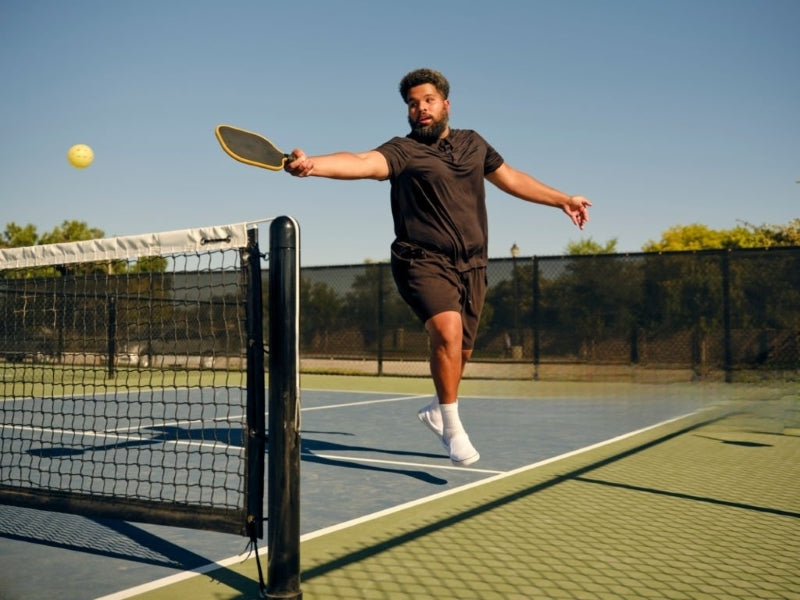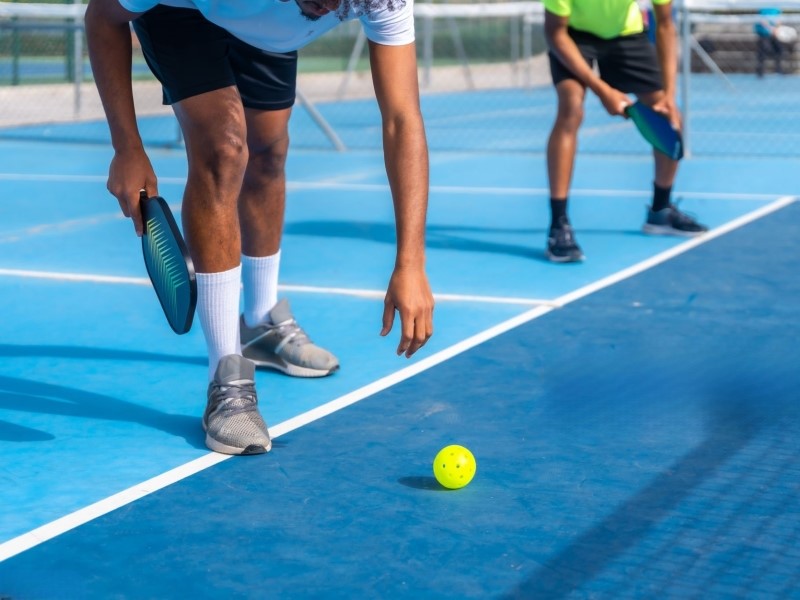A strong pickleball game starts with a proper grip. While many players focus on footwork, paddle technique, or strategy, few realize how dramatically their grip affects shot control, power, spin, and even injury prevention. Whether you're a beginner just learning how to hold the paddle or an experienced player looking to improve your precision and versatility, understanding the top three pickleball grips—Continental, Eastern, and Western—is essential.
1. Continental Grip (The “Hammer Grip”)

The Continental grip is often considered the most foundational grip in pickleball. It's similar to the way you would hold a hammer, hence the nickname. This grip is highly versatile and is used by many players, especially in doubles play, for its adaptability in quick exchanges at the net.
How to Hold the Continental Grip:
- Imagine you're holding a hammer to drive a nail.
- Your index knuckle and heel pad should be aligned with the second bevel on an octagonal paddle handle (Bevel 2).
- The paddle face stays fairly neutral, neither too open nor too closed.
Strengths of the Continental Grip:
- All-Around Versatility: Great for dinks, volleys, drop shots, blocks, and resets. You don’t have to switch grips often.
- Quick Reaction: In fast-paced net battles, the Continental grip allows for faster transitions between forehand and backhand without adjusting your hold.
- Less Wrist Stress: This grip keeps the wrist in a neutral position, which can help reduce strain and risk of injury during long matches.
- Works Well for Serves and Overheads: Although not ideal for topspin, it provides consistency and directional control.
Limitations:
- Limited Topspin Generation: Players who like to spin their serves or drive the ball aggressively may find this grip limiting.
- Forehand Drive Power: Lacks the natural leverage found in grips that position the paddle more open.
Who Should Use the Continental Grip?
- Beginners learning proper mechanics.
- Doubles players who rely on soft hands and positioning.
- Players who prefer consistency and control over raw power.
2. Eastern Grip (The “Handshake Grip”)
The Eastern grip is the most natural and popular among players transitioning from tennis. It resembles a handshake, giving a familiar and comfortable feel for many.
How to Hold the Eastern Grip:
- Shake hands with the paddle handle as if greeting someone.
- Your index knuckle should sit on the third bevel (Bevel 3).
- The paddle face will be slightly open on the forehand side, helping to lift the ball naturally.
Strengths of the Eastern Grip:
- Easy Power on Forehand Drives: Offers a strong angle for driving the ball and adding pace.
- Topspin-Friendly: The slightly closed paddle face helps generate topspin, especially on serves and third-shot drives.
- Great for Groundstrokes: Particularly effective for players who play farther from the kitchen line or in singles.
Limitations:
- Backhand Awkwardness: This grip favors the forehand; using it for backhands can feel uncomfortable or weak.
- Slower in Net Exchanges: It takes more time to adjust the paddle between forehand and backhand during quick rallies.
- May Require Grip Switching: Some players need to switch to Continental when volleying or blocking at the net.
Who Should Use the Eastern Grip?
- Players who favor baseline play and driving the ball.
- Tennis converts who are used to Eastern forehands.
- Singles players or aggressive doubles players who initiate from the back.
3. Western Grip (The Topspin Specialist)

The Western grip is the most extreme of the three. It rotates the paddle even further under the hand than the Eastern grip, allowing for massive topspin generation. However, this grip is also the most challenging to master and is rarely used in doubles-focused play.
How to Hold the Western Grip:
- Rotate your hand further clockwise (for right-handed players), so your palm is almost beneath the handle.
- Your knuckle should be positioned around the fourth or fifth bevel (Bevel 4–5).
- The paddle face is closed, encouraging an upward brushing motion.
Strengths of the Western Grip:
- Maximum Topspin: Ideal for dipping drives, sharp angles, and keeping shots low and controlled over the net.
- Effective in Windy Conditions: Topspin helps keep the ball in play even when conditions are tough outdoors.
- Powerful Passing Shots: Great for hitting fast, spinning shots that curve past your opponent at speed.
Limitations:
- Difficult Backhand Use: The extreme angle makes switching to a backhand difficult without changing grips.
- Not Ideal for Net Play: This grip is awkward for dinks, blocks, and fast reactions at the kitchen line.
- Harder to Control: Beginners may struggle to keep shots in play due to the closed paddle face and wrist-heavy motion.
Who Should Use the Western Grip?
- Advanced players with excellent timing and wrist control.
- Players who focus heavily on aggressive topspin groundstrokes.
- Those playing primarily singles or attacking from the baseline.
Side-by-Side Comparison: Pickleball Grip Overview
|
Grip Type |
Best For |
Strengths |
Weaknesses |
|
Continental |
Net play, volleys, resets |
Versatile, fast transitions, low injury risk |
Limited topspin and drive power |
|
Eastern |
Drives, forehands, spin serves |
Strong forehand, easier topspin |
Weak backhand, slower at the net |
|
Western |
Topspin groundstrokes, singles |
Max spin, aggressive play |
Poor for volleys, hard to control for new players |
Tips for Choosing the Right Grip
1. Start with the Continental Grip if you're unsure. It's the most adaptable and will help you learn proper fundamentals.
2. Experiment with Eastern if you're comfortable with forehand drives or want more topspin in your serves and groundstrokes.
3. Try the Western Grip cautiously. It’s a powerful tool in the right hands, but only if you can handle the extra spin and handle quick grip changes.
4. Practice Switching Grips: Advanced players often change grips mid-game to suit different shots. Building comfort with multiple grips expands your game.
5. Watch Your Wrist Health: If you’re experiencing wrist pain or fatigue, your grip might be too tight or putting strain on tendons. Relax your hand and avoid “choking up” too much on the handle.
How to Switch Between Different Grip Techniques
Learning how to switch grips efficiently can give you a tactical edge on the court, especially as you progress from beginner to intermediate or advanced levels. Each grip has its own strengths, and knowing when and how to transition between them can help you react better to different shots.
1.Start with the Continental grip as your base
Because the Continental grip is versatile and works well for both forehand and backhand shots, many players use it as their default. From here, you can rotate your grip slightly to shift into Eastern or Western styles depending on the situation.
2.Use the “knuckle reference” method
Your index knuckle acts as a reference point. For example:
- Move it from bevel #2 to bevel #3 = switch from Continental to Eastern.
- Rotate further to bevel #4 = Western grip.
Practicing these small hand adjustments during drills will help you get comfortable without overthinking during live play.
3. Practice shadow swings with grip changes
Hold your paddle in your starting grip, then simulate forehand and backhand strokes while consciously switching grips in between. This builds muscle memory and speed in transitions.
4. Know when to switch
- Dinking or volleying at the net? Stay with Continental.
- Driving from the baseline? Switch to Eastern for more forehand control.
- Adding topspin? Western can offer more natural brush-up on the ball.
5. Keep transitions smooth and intentional
Avoid sudden or exaggerated grip changes that disrupt timing. Grip changes should be subtle, quick, and integrated naturally into your paddle preparation.
A strong grip is more than just how you hold the paddle—it shapes the way you hit, move, and strategize on the court. Whether you're using the Continental for consistent net control, the Eastern for smooth topspin drives, or the Western for maximum spin and aggression, mastering your grip opens the door to better performance and confidence.
Experiment with each grip during practice sessions, and pay attention to how it affects your comfort, control, and results. Over time, you’ll find the perfect grip—or combination of grips—that suits your personal play style and helps you take your pickleball skills to the next level.









Leave a comment
This site is protected by hCaptcha and the hCaptcha Privacy Policy and Terms of Service apply.